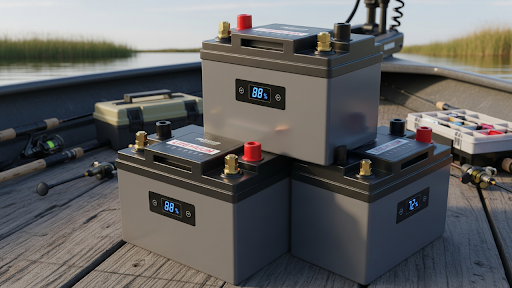For years, fishing trips meant lugging around heavy lead-acid batteries that died halfway through the day. But things have changed. More anglers across Canada are switching to a lithium trolling motor battery—and for good reason. These newer batteries aren’t just lighter or longer-lasting; they’re reshaping how people fish, from quiet backcountry lakes to big reservoirs. If you’ve ever been stranded mid-lake with a dead trolling motor, you’ll understand why this shift matters.
Lighter Weight, Easier Hauling
A standard 12V lead-acid battery can weigh 60–70 lbs. A lithium version with the same power? Around 25–30 lbs. That difference is huge when you’re loading gear into a small boat, carting it down a dock, or fishing solo.
Less weight also means:
- Better boat balance
- More room for tackle, coolers, or extra gear
- Less strain on your back during launch and load
Power That Lasts All Day
Lead-acid batteries lose voltage as they drain, which makes your trolling motor slow down—even if it’s not fully dead. Lithium keeps a steady voltage until it’s almost empty. That means consistent speed and control from sunrise to sunset.
With a quality lithium trolling motor battery, you can expect:
- Up to 2–3 times longer runtime
- Full power even at 20% charge
- No “sag” in motor performance
Charge Faster, Fish Sooner
After a long day on the water, waiting 8–10 hours to recharge is frustrating. Lithium batteries can often recharge in 2–4 hours with the right charger. Some even support partial charges without damage—so you can top up between trips.
This is especially handy during multi-day fishing weekends or tournaments.
Built Tough for Canadian Conditions
Lithium iron phosphate (LiFePO₄) chemistry—the kind used in marine batteries—is stable, safe, and handles cold better than older lithium types. While extreme cold still slows charging, these batteries perform reliably in typical Canadian spring, summer, and fall fishing temps.
They also:
- Don’t leak or spill (no acid inside)
- Work in any position—sideways, upright, even upside down
- Resist vibration from rough water or bumpy trails
Maintenance-Free from Launch to Fall
Forget checking water levels, cleaning corrosion off terminals, or trickle-charging all winter. Lithium batteries are truly “plug and play.” Just charge them before your trip, use them, and store them. That’s it.
For seasonal anglers, that simplicity is a big win.
More Usable Energy
With lead-acid, you’re only supposed to use about 50% of the battery to avoid damage. With lithium, you can safely use 80–90% of its capacity. So a 100Ah lithium battery gives you nearly twice the usable power of a 100Ah lead-acid.
That means fewer battery swaps and more time fishing deep structure or drifting quietly along weed lines.
Better Over Time—Even with the Higher Upfront Cost
Yes, lithium costs more at first. But it lasts 5–10 years, compared to 2–3 for lead-acid. Over time, that’s fewer replacements, less hassle, and lower cost per season.
Plus, many come with built-in battery management systems (BMS) that protect against:
- Overcharging
- Deep discharge
- Short circuits
- Overheating
That extra safety gives peace of mind, especially on remote lakes.
Pairs Perfectly with Modern Gear
Today’s trolling motors, fish finders, and GPS units all run on stable 12V (or 24V/36V) systems. Lithium delivers clean, consistent power that helps sensitive electronics work their best—no voltage spikes or drops. And if you’re using solar panels on your boat or camper, lithium charges more efficiently from solar than lead-acid ever could.
Bottom Line
The days of wrestling with bulky, short-lived batteries are fading fast. Anglers who make the switch find they fish longer, move quietly, and stress less about power. Whether you’re chasing walleye on Lake of the Woods or bass on the St. Lawrence, a lithium trolling motor battery gives you reliable, lightweight, and long-lasting energy—so you can focus on what really matters: the next bite.


